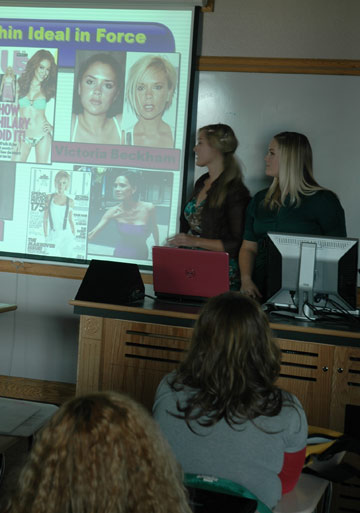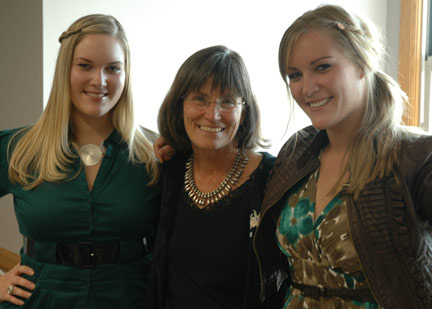JCOM alums urge girls to ignore media messages and ‘love your body’
October 24th, 2009 Posted in Arts and LifeBy Brendon Butler
Lindsay and Lexie Kite have a message for all young women: you can love your own body and feel beautiful even if you don’t look like a Barbie doll.
The 24-year-old twins spent the past two years at the University of Utah working on an unusual combined master’s thesis, collecting images from television and magazines to show how the media misrepresent ‘real’ women.
On Wednesday—which was national Love Your Body Day—the USU JCOM grads returned to their alma mater to give an hour-long visual presentation on exactly how the entertainment media distort women’s bodies to create a version of beauty that is unattainable for most young women.

“Remember,” Lexie Kite told 25 members of Brenda Cooper’s Gender & Media class, “you will never see an average American woman represented in the mass media as a ‘beauty ideal.’ It is completely reasonable to assume that every image of women you see in the media has been digitally manipulated.”
When magazines use computer programs to brush out flaws and augment women’s breasts, and when television programs portray women as having power only in their sexual prowess, they help create another generation of young women who hate their bodies, the twins say.
“We look at media and on average we look at 3,600 advertisements a day,” said Lexie, who graduated USU with double majors in speech communication and print journalism. “So we’re seeing image after image after image of what women look like and what they should look like, and that skews our perception of what ‘average’ is.”
The sisters have traveled to middle and high schools throughout Utah to give their presentation to young women. Last spring they presented to about 40 young at-risk girls in the Salt Lake.
“In our lives we’ll see millions more women in media than we’ll ever see face to face, and when we see every one of those images over and over again, we start to build this idea about what we should look like and how we should be acting, as women,” Lexie said.
“That fully changes the way a girl grows up. So if we can talk to these girls about how to recognize how women are portrayed and about how unrealistic that is compared to their reality; compared to how they act, compared to how they look and who loves them, then we can help them learn to reject those messages and get on to what’s really important … to focus on other things than just ’how bad I hate my body’ and how successful they can be not based on appearance.”
Lindsay says there is a “thin ideal” in media that is well documented in scholarly research. Women are consistently represented at a weight that is lower than the average population, often that is under the criteria for anorexia. According to one study, the incidence of bulimia among 10- to 39-year-old girls and women tripled between 1988 and 1993. And, the Kites say, that trend is accelerating.
“This is not just in advertisement but also in entertainment media — films, television, magazines,” Lindsay said. “There is also a ‘whiteness’ ideal, so that very few women of color are represented in media at all, and if they are represented as beautiful women then they already look like white women already with long straight hair and thin figures, things like that.”
The sisters’ traveling high school presentation is a “one time intervention” to show girls they aren’t not necessarily outside the norm, even though they look so different than what is represented in the media all the time, Lindsay said.
Advertisers’ motives for creating unattainable ideals are clear, she said, because consumers will buy products to try to attain the unattainable standard of beauty. There’s even term for it, she says: “normative discontent” — 90 percent of American women say they are unhappy with their own bodies, a discontent fueled by mass media portrayals.
A recent Self magazine cover showing singer Kelly Clarkson was changed so dramatically that she is unrecognizable, say the twins. In their presentation they show a video clip of Clarkson performing on “Good Morning America” in the same week the magazine cover appeared on newsshelves. Her video shows a vastly different, air-brushed body than the magazine cover.
There has been some change recently, say the twins. A recent advertising campaign from Dove beauty products emphasizes the many different types of beauty ideals among women, and an upcoming photo spread in Glamour magazine shows a group of women who are of truly average weight posing in the buff. The unattainability of the entertainment media’s beauty ideal is emphasized by the photo, which shows women who range from size 8 to size 12. Even though the size range is completely average, says Lindsay, the women are called “plus size” in media parlance.
The average American woman today is 5 feet, 4 inches tall, and weighs 163 pounds, which is a size 14 dress, the sisters told the students. The average model is 5-11 and weighs 117 pounds, and wears size zero or smaller clothes.

The twins say they first found their interest in gender studies after taking JCOM’s Media Smarts class, taught by professor Brenda Cooper. When the class discussed the issue of misrepresentation of women’s bodies in the media, both sisters felt moved, says Lindsay.
“When we started talking about gender and body image in her class, we both just felt basically goosebumps,” she said. “You start to feel that, ‘This is my life…I have felt these things.’
“In the media you’ll see that the key to happiness and success and relationships and careers and anything else is basically being as thin as possible and attracting as many men as possible. But in our own lives, that has never been the case. I don’t know any women who have only attained success in their careers by being stick thin to the criteria of anorexia.”
The two girls are star products of USU’s journalism and communication department, says Cooper, who mentored the twins during their undergraduate years. Since completing their master’s degrees, they have entered the University of Utah’s doctoral program in communication, and plan careers in teaching and research.
“We’re really proud of them,” she said.
Tags: body image, Lexie Kite, Lindsay Kite, media misrepresentation, women

Sorry, comments for this entry are closed at this time.